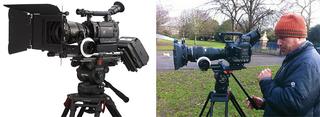Finally… We Get a Big Picture
You might not have noticed, but the cost of real estate is coming down.
I'm not talkin' about the beating you took on your McMansion's resale value; or, in the case of us engineers, how your beloved hovel, Casa Interlace, is now worth about the same as a cardboard refrigerator box. I'm talkin' another kind of real estate… pixels.
Time was that the surface area of a Plumbicon camera tube told you what kind of picture quality to expect.
But, as cameras shrank to shoulder-sized, so the imagers inside shrank, too. Preamps, matrices and post-processing lessened the nasty effects, but cameras didn't actually improve with the march of time; they seemed stuck with all the astounding quality of a 1975 big-tube model. Sure, the cams were pretty ratty in low light, but, hey… whaddya want for $50K? Magic?
The "digital revolution" might have revolted in your neighborhood, but in mine, a marginal-quality 2/3-inch camera tube became a marginal-quality half-inch CCD chip… now there's progress. One camera company even changed its corporate tagline: "Where 'good enough' is our very best." And when HD arrived, it was assumed that only the smallest physical chip possible would placate the camera marketplace.
And that, my children, is the Reader's Digest version of what got us into our current pixellated pickle: the rise of the DSLR.
WORKAROUNDS AND EXCUSES
Now, don't get me started on the overall stupidity of the DSLR workflow… there aren't enough hours in the day. Unusable form factor, skinny storage, split-system audio recording, jellocam distortion. And a hot image sensor chip that shuts the camera down every 10 minutes or so.

Sony's PMW-F3 (left) and Panasonics's new AG-AF100 cameras are among the first digital cameras in the companies' product lines to sport new big-sensor imagers.
But I never said the DSLR dudes were wrong.
Fact was, the big, fat sensor in a DSLR—capable of way beyond 1920x1080 HDTV—had enough geography to shoot in astoundingly low-light conditions. And that meant ultra-short depth of field, candlelit love scenes, cops-and-robbers night shots… all the shortcomings our cinematic brothers and sisters used to laugh so heartily about when we showed 'em our high-def cameras.
In retrospect, here was the ultimate dopey question: If the DSLR nuts were willing to jump through hoops to cobble together audio, camera support and storage workarounds, all for the sake of a bigger chip, why couldn't somebody just make a big-sensor video camera?
Simultaneously, light bulbs appeared over camera marketers' heads all over the globe. Well, maybe not all over; maybe just Japan… and maybe just two companies… whatever.
SENSORS EMBIGGENED
Turns out, both companies actually knew how to make a big sensor; they both sold DSLRs with pretty honkin' big chips. One of 'em—let's call it "Company P"—looked at its customer-focused mandate, and decided to be responsive—to jump right in and answer the call. Like lightning, their standard micro-four-thirds DSLR chip was cemented into a TV camera body, with multitrack audio, AVCHD recording and interchangeable lenses. Voila.
The other company—"Company S"—did nothing. Some critics weren't surprised.
At least it seemed like they didn't do anything. In reality, though, the elves in the research labs worked night and day calculatin' and blowin' chips. And spyin'. In the development process, they ran right up to the cinema guys' houses and peeked in the windows. And what did they see?
Big surprise… the "big boys" weren't playin' 'round with micro-four-thirds and old SLR lenses; their film cameras used pretty much what they'd always used—a 35mm gate and cinema prime lenses.
Back in the salt mines, the elves pounded out a big 35mm imager with a unique array of sensors, designed to overcome that lag that made horizontal motion so wobbly. They gave it a mount with electrical connections for all lenses, great and small.
And then… they screwed it into every camera they could, from the megabucks Electronic Cinematography systems right down through the rest of the line, including the little $6K indiecam.
The net result: two mainstream, trusted camera-makers with a host of choices between them. Big sensors abound, and you're the winner.
Now, you know ol' Mario can't afford to play favorites, and just because one of the "big two" seems to be out front, well, that doesn't mean there isn't another shoe waiting to be dropped somewhere. Prepare for the next volley in this battle… competing chips, cameras and systems that do more and cost less.
But permit me to strike a quasi-political pose for a moment, and opine this: The falling price of (pixel) real estate—thanks to ingenuity and competition—means real democracy for the rest of us, because now anyone can own a really great camera. Time to brush up on talent, because you can't blame the equipment any more.
Get the TV Tech Newsletter
The professional video industry's #1 source for news, trends and product and tech information. Sign up below.
